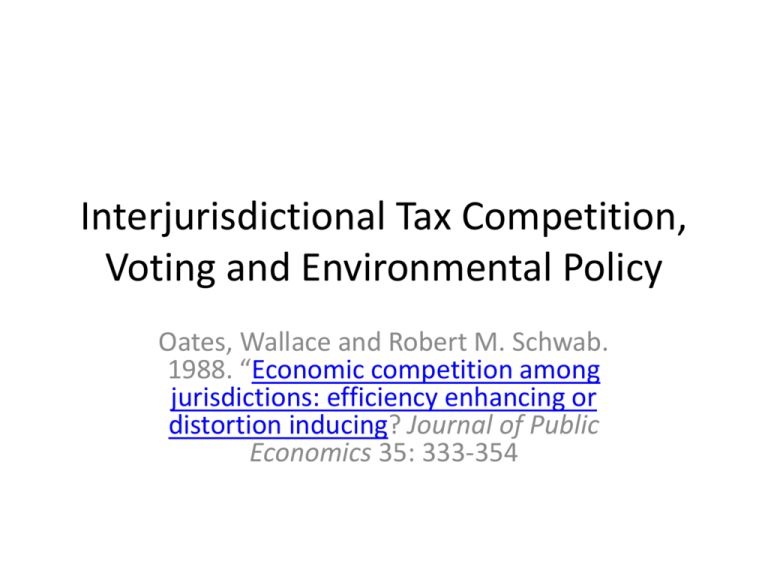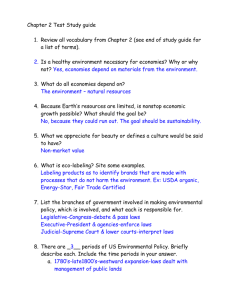Interjurisdictional Tax Competition, Voting and Environmental Policy
advertisement

Interjurisdictional Tax Competition, Voting and Environmental Policy Oates, Wallace and Robert M. Schwab. 1988. “Economic competition among jurisdictions: efficiency enhancing or distortion inducing? Journal of Public Economics 35: 333-354 Assumptions • • • • • capital is mobile capital augments labor production generates emissions pollution is local firms perfectly competitive and have CRS production functions • n jurisdictions (provinces) sell their numeraire output Q in a single national market Regulation: • government caps total local emissions by putting a limit on emissions • per worker cap on aggregate local emissions, emission permits bundled with labor • capital tax = t Equilibrium • treat r as exogenous (determined in ROW) • equilibrium condition: fk-t=r (2) where fk = marginal product of capital Homogeneous Population • If everyone is the same, want to set t=0, and choose pollution policy so that marginal rate of substitution between consumption and environmental quality equals marginal product from higher emissions. • I.e. set efficient policy. • Somewhat reassuring: interjurisdictional competition alone won’t necessarily breed inefficient environmental policy. Heterogeneous Populatios • two types of voters: –workers –folks with outside income • Any revenue generated by capital taxation is rebated lump-sum to all local citizens equally. Worker majority • If workers are in the majority, they will elect to subsidize capital, setting tk<0. • This subsidy attracts capital, which augments the wage. • The jurisdiction would have to finance the subsidy by levying lump-sum taxes on the entire local population. Intuition • “Workers reap all the gains from the increased wage income associated with a larger capital stock, but they do not bear the full cost of the subsidy to capital---some of the cost of the subsidy falls on non-wage earners.” (p.347) • Moreover, since tl<0, have a fiscal incentive to repel capital – choose implicit pollution tax that’s less than MD. Non-wage earner majority • Will elect to tax capital---pure “fiscal” effect. • Ambiguous as to whether implicit pollution tax is > or < MD – May want high pollution tax so as to secure clean environment at expense of local workers – or may want to expand tax base by weakening environmental policy. Conclusions • Inter-jurisdictional competition for capital doesn’t necessarily induce inefficient policy • whether voting leads to inefficiently weak environmental policy depends on who is in majority – needn’t be capital owners in charge in order to see capital get subsidized Lumpy Investment Markusen, James, Edward Morey and Nancy Olewiler. 1995. "Competition in Regional Environmental Policies When Plant Locations are Endogenous," Journal of Public Economics 56: 55-77. • build a two-region model • single firm • investment is lumpy – there are fixed costs associated with opening a new plant • transporting finished products is costly competing concerns • countries want to host investment for two reasons: – avoid transport costs – pollution tax revenue • downside – production pollutes local environment Game • Governments set binding tax rates • Firm decides how many plants to build and where Policies • Each government extracts rents from the firm, setting pollution tax higher than MD – Makes it profitable to host the firm • Also charge export taxes – gives governments incentives to bid down own tax rates so as to get the firm to shut down its overseas plant and capture export tax revenue One possible outcome • Not In My BackYard: – both countries set pollution taxes too high – firm doesn’t set up anywhere – both countries could be better off if one would agree to host the firm and receive side payments from the other Conclusion • Quest for lumpy investment can induce governments to bid down their pollution taxes, eroding benefits from hosting dirty industry – too much pollution • Possible outcome: no one wants to host – too little pollution Reconciling MMO w/ O&S Levinson, Arik. 1997. “A Note on Environmental Federalism: Interpreting some Contradictory Results” JEEM 33: 359-366 • MMO suggest interjurisdictional competition drives down pollution taxes • O&S suggest τ>MD What’s the difference? • there are monopoly profits in MMO, which are ignored by the policy makers • In O&S the capital rate is exogenous, so there are no costs/benefits to capital owners from weak/strict environmental regulation • Levinson redoes MMO, taking into account the firm’s profits. • compares “non-strategic, strategic, and paretooptimal tax rates, pollution levels, welfare and profits” (p.361) Finds... • “when profits are included in the welfare calculations, the ...[competitive] tax rates lead to higher welfare than the non-strategic...tax rates and are closer in spirit to the Pareto optimum” (p.361)







